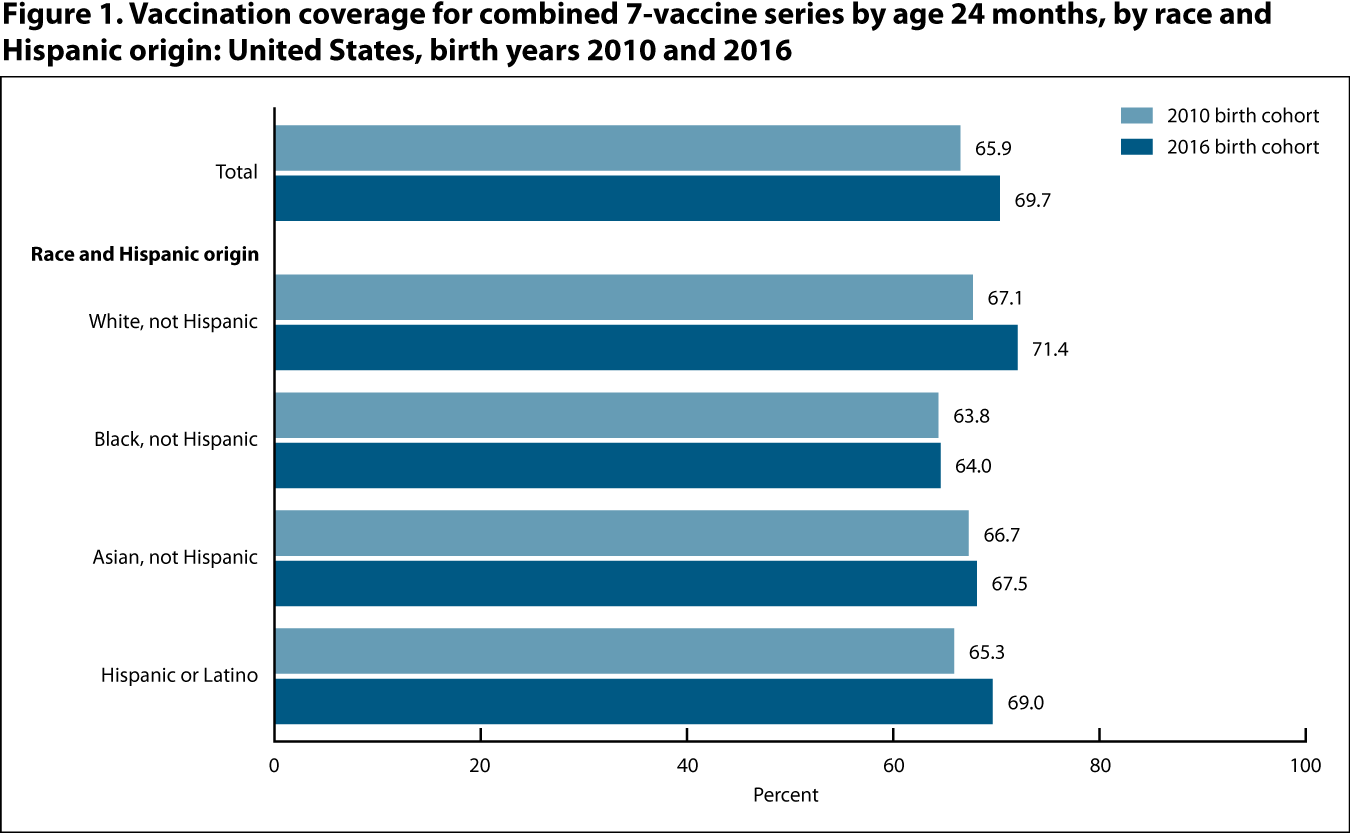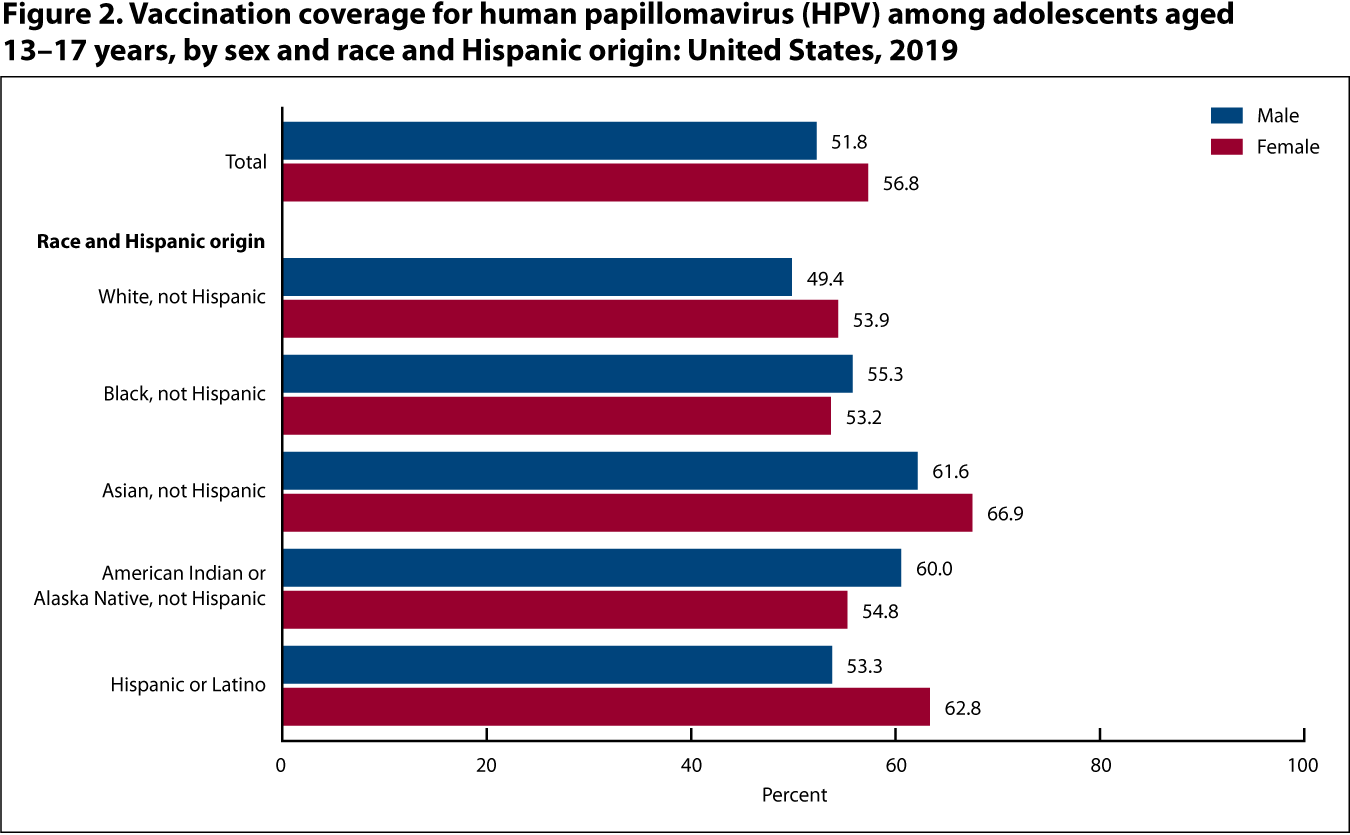Vaccination
The content on this page was last updated in June 2023. More recent estimates and visualizations may be available from the NCHS Data Query System.
The introduction of vaccines led to substantial achievements in the control of infectious diseases (1). Many notifiable infectious diseases, such as diphtheria, measles, polio, tetanus, and rubella have been virtually eliminated in the United States through vaccination (2). In the United States, guidelines currently recommend vaccination against 14 potentially serious illnesses by the time a child reaches age 24 months (3,4). Three vaccines, Tdap, MenACWY, and HPV vaccine, are routinely recommended to prevent diseases in adolescents, including pertussis, meningococcal disease, and human papillomavirus (HPV) (4,5).
Key Findings
Vaccination coverage with the combined 7-vaccine series among children by age 24 months

For children born in 2016, 69.7% received the combined 7-vaccine series by age 24 months as reported in 2017–2019, a 5.8% increase from 65.9% among children born in 2010. See Featured Charts for additional analysis.
SOURCE: CDC, National Center for Immunization and Respiratory Diseases, National Immunization Survey-Child. See Sources and Definitions, National Immunization Surveys (NIS) and Health, United States, 2020–2021 Table VaxCh.
Vaccination coverage for human papillomavirus (HPV) among adolescents aged 13–17 years


The percentage of adolescents aged 13–17 who were fully vaccinated against HPV was higher in 2019 than in 2016 for females (56.8% compared with 49.5%) and males (51.8% compared with 37.5%). See Featured Charts for additional analysis.
SOURCE: CDC, National Center for Immunization and Respiratory Diseases, National Immunization Survey-Teen. See Sources and Definitions, National Immunization Surveys (NIS) and Health, United States, 2020–2021 Table VaxTn.
Non-Hispanic Black children born in 2010 and 2016 were less likely to receive the combined 7-vaccine series than non-Hispanic White children.

SOURCE: National Center for Immunization and Respiratory Diseases, National Immunization Survey-Child. See Sources and Definitions, National Immunization Surveys (NIS) and Health, United States, 2020─2021 Table VaxCh.
- The percentage of children who received the combined 7-vaccine series by age 24 months was higher for non-Hispanic White children born in 2016 (71.4%) than in 2010 (67.1%), while the percentages did not differ for children of all other race and Hispanic-origin groups.
- For both the 2010 and 2016 birth cohorts, non-Hispanic Black children were less likely to receive the combined 7-vaccine series than non-Hispanic White children. Vaccination coverage for non-Hispanic Asian and Hispanic children did not differ from non-Hispanic Black or non-Hispanic White children.
In 2019, non-Hispanic Asian and Hispanic female adolescents were more likely to be fully vaccinated against HPV than non-Hispanic White and non-Hispanic Black female adolescents.

SOURCE: National Center for Immunization and Respiratory Diseases, National Immunization Survey-Teen. See Sources and Definitions, National Immunization Surveys (NIS) and Health, United States, 2020─2021 Table VaxTn.
- In 2019, female adolescents aged 13–17 (56.8%) were more likely to be fully vaccinated against HPV than male adolescents (51.8%).
- Among non-Hispanic White and Hispanic adolescents, females were more likely to be fully vaccinated against HPV than males in 2019. HPV vaccination coverage was not different by sex among other race and Hispanic-origin groups.
- Among female adolescents, non-Hispanic Asian (66.9%) and Hispanic (62.8%) people were more likely to be fully vaccinated against HPV than non-Hispanic White (53.9%) or non-Hispanic Black (53.2%) people in 2019. Among non-Hispanic Asian adolescent females, the percentage fully vaccinated against HPV was not significantly different from Hispanic female adolescents in 2019.
Download the data
Vaccination coverage for selected diseases by age 24 months, by race and Hispanic origin, poverty level, and location of residence: United States, birth years 2010–2016
SOURCE: Centers for Disease Control and Prevention, National Center for Immunization and Respiratory Diseases, National Immunization Survey-Child.
Vaccination coverage for selected diseases among adolescents aged 13–17 years, by selected characteristics: United States, selected years 2008–2019
SOURCE: Centers for Disease Control and Prevention, National Center for Immunization and Respiratory Diseases, National Immunization Survey-Teen.
Selected nationally notifiable disease rates and number of new cases: United States, selected years 1950–2019
SOURCE: Centers for Disease Control and Prevention, National Notifiable Diseases Surveillance System and Centers for Disease Control and Prevention, National Center for HIV/AIDS, Viral Hepatitis, STD, and TB Prevention.
- Hispanic origin: People of Hispanic origin may be of any race. See Sources and Definitions, Hispanic origin.
- Notifiable disease: A disease that, when diagnosed, requires health providers (usually by law) to report to state or local public health officials. Notifiable diseases are of public interest by reason of their contagiousness, severity, or frequency. See Sources and Definitions, Notifiable disease.
- Vaccination: The process of using a vaccine to stimulate the immune system to become protected against a disease. See Sources and Definitions, Vaccination for more information about preventable diseases.
- Race: Estimates are presented according to the 1997 Office of Management and Budget’s “Revisions to the Standards for the Classification of Federal Data on Race and Ethnicity” and are for people who reported only one racial group. See Sources and Definitions, Race.
- Centers for Disease Control and Prevention. Ten great public health achievements–United States, 2001–2010. MMWR Morb Mortal Wkly Rep 60(19):619–23. 2011.
- Centers for Disease Control and Prevention. Diseases you almost forgot about (thanks to vaccines).
- Hill HA, Singleton JA, Yankey D, Elam-Evans LD, Pingali SC, Kang Y. Vaccination coverage by age 24 months among children born in 2015 and 2016—National Immunization Survey-child, United States, 20162018. MMWR Morb Mortal Wkly Rep 68(41):913–8. 2019.
- Robinson CL, Bernstein H, Poehling K, Romero JR, Szilagyi P. Advisory Committee on Immunization Practices recommended immunization schedule for children and adolescents aged 18 years or younger—United States, 2020. MMWR Morb Mortal Wkly Rep 69(5):130–2. 2020.
- Elam-Evans LD, Yankey D, Singleton JA, Sterrett N, Markowitz LE, Williams CL, et al. National, regional, state, and selected local area vaccination coverage among adolescents aged 13-17 years—United States, 2019. MMWR Morb Mortal Wkly Rep 69(33):1109–16. 2020.

